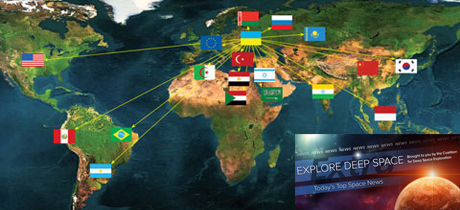In Today’s Deep Space Extra… Interest in NASA’s plans to return to the moon with human explorers is attracting the interest of other nations and scientists as well as those from the private sector. Astronauts from many nations say their time in space has shaped their views of humanity. NASA astronaut Scott Tingle commands a robot in Europe from the International Space Station. European experts narrow their estimates for re-entry of China’s Tiangong-1 space station.
Human Deep Space Exploration
Gerstenmaier: U.S. leadership in space is “ours to lose” if direction changes too many times
Spacepolicyonline.com (3/5): In remarks before the Space Transportation Association in Washington this week, Bill Gerstenmaier, NASA’s associate administrator of Human Exploration and Operations, characterized the U.S. as in a strong position to lead internationally in the exploration of space, an advantage it could lose if it makes too many changes in direction.
NASA sees strong international interest in lunar exploration plans
Space News (3/6): A global community is interested in joining NASA in human activities around the moon, Bill Gerstenmaier, NASA’s associate administrator for Human Exploration and Operations, told a Washington gathering of the Space Transportation Association earlier this week. ”It’s clear the U.S. is a leader throughout the international space community” said Gerstenmaier, after participating in the last week’s Second International Space Exploration Forum in Tokyo. However, NASA cannot accommodate all of the potential partners as it prepares to establish a Lunar Orbital Platform-Gateway (LOPG).
U.S. scientists plot return to the moon’s surface
Nature (3/6): Planetary scientists are eager for the opportunity to participate in the Trump administration’s plans to resume human exploration of the moon, as outlined in NASA’s 2029 budget proposal. Among their interests is prospect for lunar water and its distribution on the moon.
They saw Earth from space. Here’s how it changed them
National Geographic (March): The men and women who’ve flown in space as astronauts for many of the world’s space agencies agree that the experience has shaped their view of humanity. “If you look at it on a geologic timescale, it’s almost like we are this flimsy presence, and we really have to stick together as a human family to make sure we are a permanent presence on this planet and not just this blink of an eye,” explains Samantha Cristoforetti, an Italian European Space Agency astronaut.
Astronaut Scott Tingle was able to control a ground-based robot from space
Universe Today (3/6): Though not a first, NASA astronaut Scott Tingle demonstrated earlier this month that he could command a robot in Europe through a solar array maintenance task from his control post aboard the International Space Station. The ground-based activities with the robot Justin were managed by the European Space Agency and the German Aerospace Center.
Air and Space Magazine (3/6): Despite recent White House enthusiasm for a human return to the moon, there are challenges. Among them, preparing landers, space suits and shelters for long stays by human explorers. The newly formed Moon Village Association would like to see a paced return that follows surface robotic activities and investments in infrastructure.
Other News
Commerce Department pressing ahead with commercial space regulatory reform
Space News (3/5): Backed by a set of recommendations endorsed by the National Space Council, the Secretary of Commerce says he is moving ahead with efforts to improve the regulatory environment for commercial space. In an interview here shortly before the March 1 launch of the GOES-S weather satellite on an Atlas 5, Secretary of Commerce Wilbur Ross said he has support within his own department, and elsewhere in government, to start enacting reforms that would make the department a “one-stop shop” for most commercial space regulatory activities.
European Space Agency (3/6): Predictions of when China’s Tiangong-1 space station will make an uncontrolled re-entry in to the Earth’s atmosphere have narrowed to between March 29 and April 9. The 8 1/2 ton space lab was launched in 2011 and staffed twice, most recently in 2013. The spacecraft orbits the Earth between 43 degrees North and South latitude.
Washington Post (3/6): Paul Allen, who helped to pioneer human commercial spaceflight with an Ansari X-Prize victory, may have bigger things in store with his Stratolaunch project. The world’s largest airplane is to carry rockets into the air for launch. One prospect is Black Ice, a possible space shuttle like spacecraft that could include the International Space Station among its destinations.

